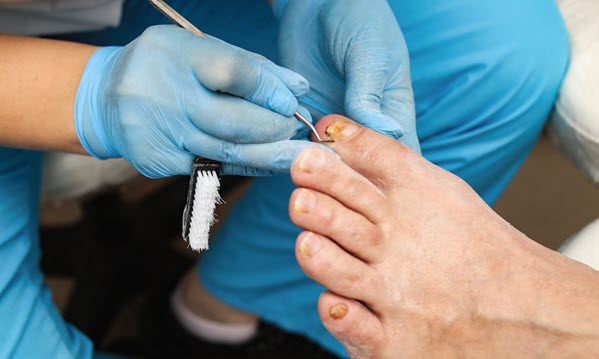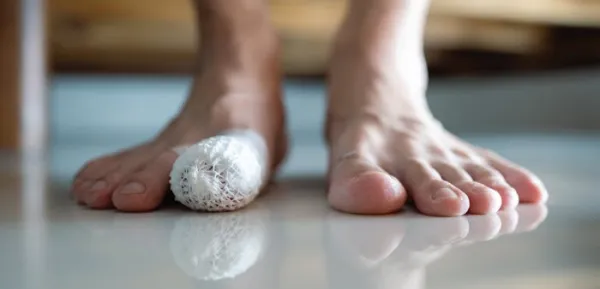Solve This Scenario, Dodge a Nail Matrix Removal Mishap
Hint: Know the difference between nail removal descriptors. A patient presents for a follow-up for treatment on an ingrown toenail. Your podiatrist finds that the patient now has two ingrown toenails — one on each foot. The physician removes both the nail and nail matrix from each of the two toes and also performs a silver nitrate cauterization. How would you capture this patient encounter using the appropriate procedure codes? Are you familiar with the CPT® descriptors that would guide your coding selection? Let’s dive deeper and assess your familiarity with this often-seen situation in podiatry clinics. Step 1: Review Your Options You might consider using code 11730 (Avulsion of nail plate, partial or complete, simple; single). Code 11730 is normally used when there has been extensive damage to a nail, and it requires medical removal. The procedure for 11730 begins with a digital nerve block to numb the top of the digit. The physician bluntly dissects the nail plate from the nail bed. Any bleeding is cauterized. The digit is bandaged. You should report 11730 if only one nail plate is removed. If more than one nail plate is removed, you will report 11732 (…each additional nail plate (List separately in addition to code for primary procedure)) for each additional nail plate removed. Keep in mind, however, that this procedure will still allow for regrowth of the nail. Another possible choice is 11750 (Excision of nail and nail matrix, partial or complete (eg, ingrown or deformed nail), for permanent removal). During this procedure, the physician removes all or part of a fingernail or toenail, including the nail plate and matrix, permanently. The nail plate is bluntly dissected and lifted away from the nail bed. The nail plate is then detached from the matrix using a scalpel. Afterward, the matrix or nailbed is destroyed through CO2 laser, chemical ablation, or electrocautery to prevent it from ever growing back. Code 11765 (Wedge excision of skin of nail fold (eg, for ingrown toenail) may also seem plausible for this patient encounter. For this procedure, the provider will apply local anesthesia before making an oval-shaped cut through the layers of skin near the affected nail groove. The provider then makes a triangular cut to eliminate soft tissue from the margins of the nail. Finally, the provider stitches the wound closed to aid in the healing process. The provider may perform this procedure to treat an ingrown toenail where the lateral edge of the nail has grown under the tissue on the sides of the nail resulting in pain, inflammation, or infection. This procedure does not include excision of the nail plate or matrix. Step 2: Choose the Appropriate Code After carefully reviewing the description of each CPT® code above and comparing it to the procedure performed by the podiatrist, the most appropriate code for the procedure is 11750. This is the clear choice because not only did the practitioner remove both ingrown toenails from each great toe, but they also performed a silver nitrate cauterization to prevent regrowth of the nails, which is considered a chemical ablation. The option to use 11730 would be inappropriate in this scenario because the practitioner is removing the nail due to being ingrown, not from being damaged. Also, the practitioner is removing the patient’s ingrown nails completely and permanently. Code 11730 is used in situations where the podiatrist is only temporarily removing a damaged nail and would like the nail to eventually grow back healthier than when it was removed. Code 11765 would also be incorrect in this scenario because the podiatrist removed the nail and nail matrix completely. This code is better fitted for instances where only a segment of the ingrown nail, including some surrounding soft tissue, is being removed instead of the whole nail. Coding tip: When your podiatrist performs multiple toenail removals on separate toes in the same visit, code 11750 for the first complete removal and 11750 for the second removal, appending modifier 59 (Distinct procedural service) to the second removal. This will tell the payer that the podiatrist performed a second ingrown toenail removal on a different toe. Also, be sure to use anatomic modifiers to emphasize the procedure was performed on two separate nails, using 11750-T5 (Right foot, great toe) and 11750-59-TA (Left foot, great toe) as appropriate. Keep in mind that 11750 is a permanent, once-in-a-lifetime procedure as it will result in complete removal of the toenail. Step 3: Proving Medical Necessity Is a Must Because this is a follow-up visit for the same condition, a payer may view this as a repeat procedure. To ensure payment of your claim, the documentation must be very clear and specific, providing reasons for the failure of the previous complete removal (if that is the case) or why it is believed to have failed. Due to this, “many providers are now performing procedures on both borders (even if not medically necessary) to avoid potential issues when patients have to return for a second procedure, which might not be covered since the same toe was already treated,” says Jennifer McNamara, CPC, CCS, CPMA, CRC, CDEO, COSC, CGSC, COPC AAPC Approved Instructor, CEO and physician education at Healthcare Inspired, LLC, in Bella Vista, Arkansas. Modifier alert: If you had billed 11750 during the patient’s initial visit and billing the repeat procedure on the same toe is unavoidable during this follow-up, you can add modifier KX (Requirements specified in the medical policy have been met) to the claim, assuming you have sufficient documentation to prove it was medically necessary. To use modifier KX, the medical documentation needs to precisely detail the condition; for instance, noting if there’s an ingrown nail on the other edge or a newly discovered significant disease on the same edge that was previously treated. “The documentation should indicate why the procedure was repeated on the same border and what new pathology is present, or that it was on a different border. An advance beneficiary notice [ABN] is not needed as long as the justification for repeat procedure meets these guidelines, although, I would still obtain one,” says Tonia Silva, CPC, CPPM, owner of Enhanced Billing Solutions in Lakeport, California.





